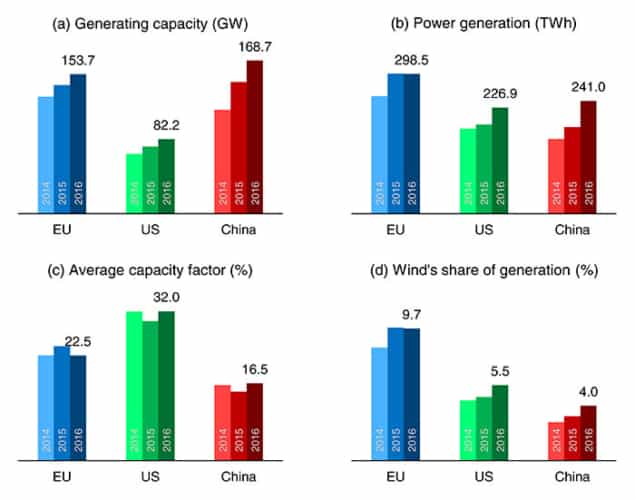
China has made large investments in wind power over the past decade, but estimates suggest that Chinese wind farms are producing less electricity than hoped for. Writing in Environmental Research Letters (ERL), a team advises that if the country is to achieve national goals and increase utilization up to US levels, in addition to addressing the much-discussed issues related to grid integration, China will need policy measures to address turbine siting and technology choices.
The study concludes that the gap between actual performance and technical potential is driven by delays in grid connection (14% of the gap) and curtailment due to constraints in grid management (10% of the gap). But the analysis doesn’t stop there.
“Our findings show that China’s underperformance is also driven by suboptimal turbine model selection (31% of the gap), wind farm siting (23% of the gap), and turbine hub heights (6% of the gap) – factors that have received less attention in the literature and, crucially, are locked-in for the lifetime of wind farms,” explain the authors, who were supported by Harvard University, US, and are now at the University of Minnesota, US, Florida State University, US, and Cambridge University, UK.
China aims to reach 210 GW of grid-connected wind capacity by 2020, as part of its 13th Energy Technology Innovation Five Year Plan . Today, it’s thought that the country has a capacity in the region of 169 GW, compared with 154 GW for the EU and 82 GW for the US.
However, as the team points out, it’s important to look beyond the installed capacity and examine how much electricity is fed into the electric grid to displace conventional, polluting power sources.
“In 2016, the European Union generated 36% more electricity per unit of installed wind capacity than China, and the United States generated 93% more,” calculate the researchers in their study.
The scientists note that China generated in the region of 241 TWh of wind power from its installed capacity of around 169 GW. These figures imply an approximate capacity factor of 16.5%, which compares with 32% for the US.
By digging deeper into the reasons, scientists hope to improve China’s prospects of maximizing the human health and environmental benefits that wind power has to offer.
A key feature of the work is the use of wind farm-level data to reveal the relative importance of each driver. These rankings highlight that design choices such as location, tower height and turbine model play a major role in whether a project meets its objectives. The overall picture, though, is one of being able to strike a balance.
Trade-offs include land availability and prices, wind resource quality, proximity of the site to the electric grid and service roads, and the level of available feed-in tariffs to guarantee revenue.
Another recommendation from the team is to increase access to multi-year wind measurements at specific locations, particularly where planners currently rely on short-term wind measurements or measurements from nearby weather stations.
Now the researchers are looking to apply these results to inform China’s national greenhouse gas emission reduction policies.



